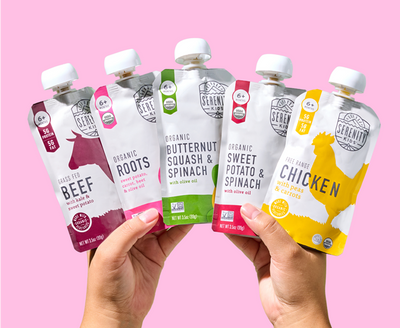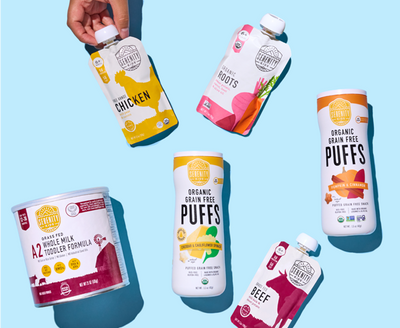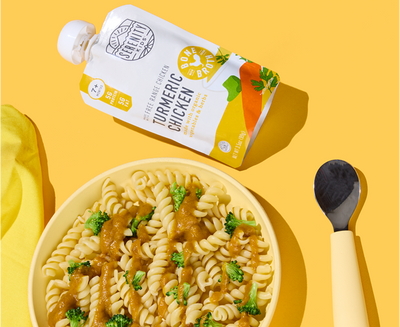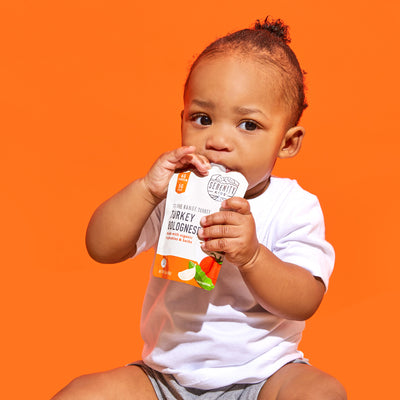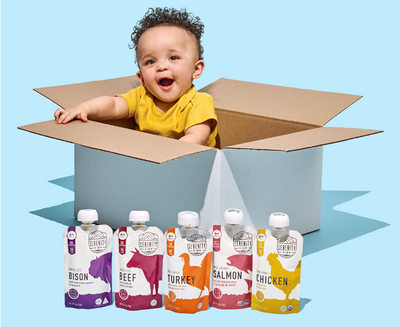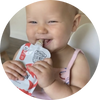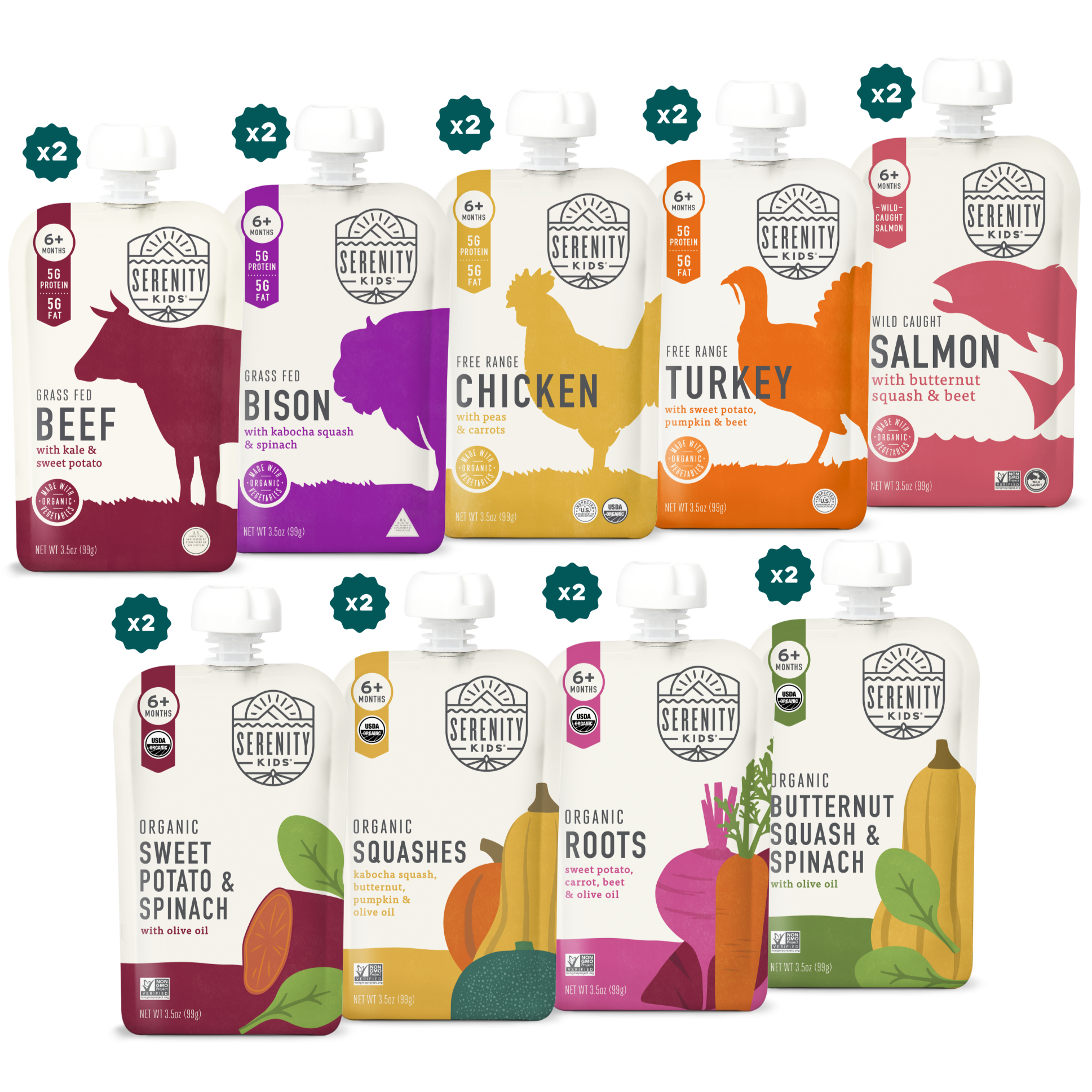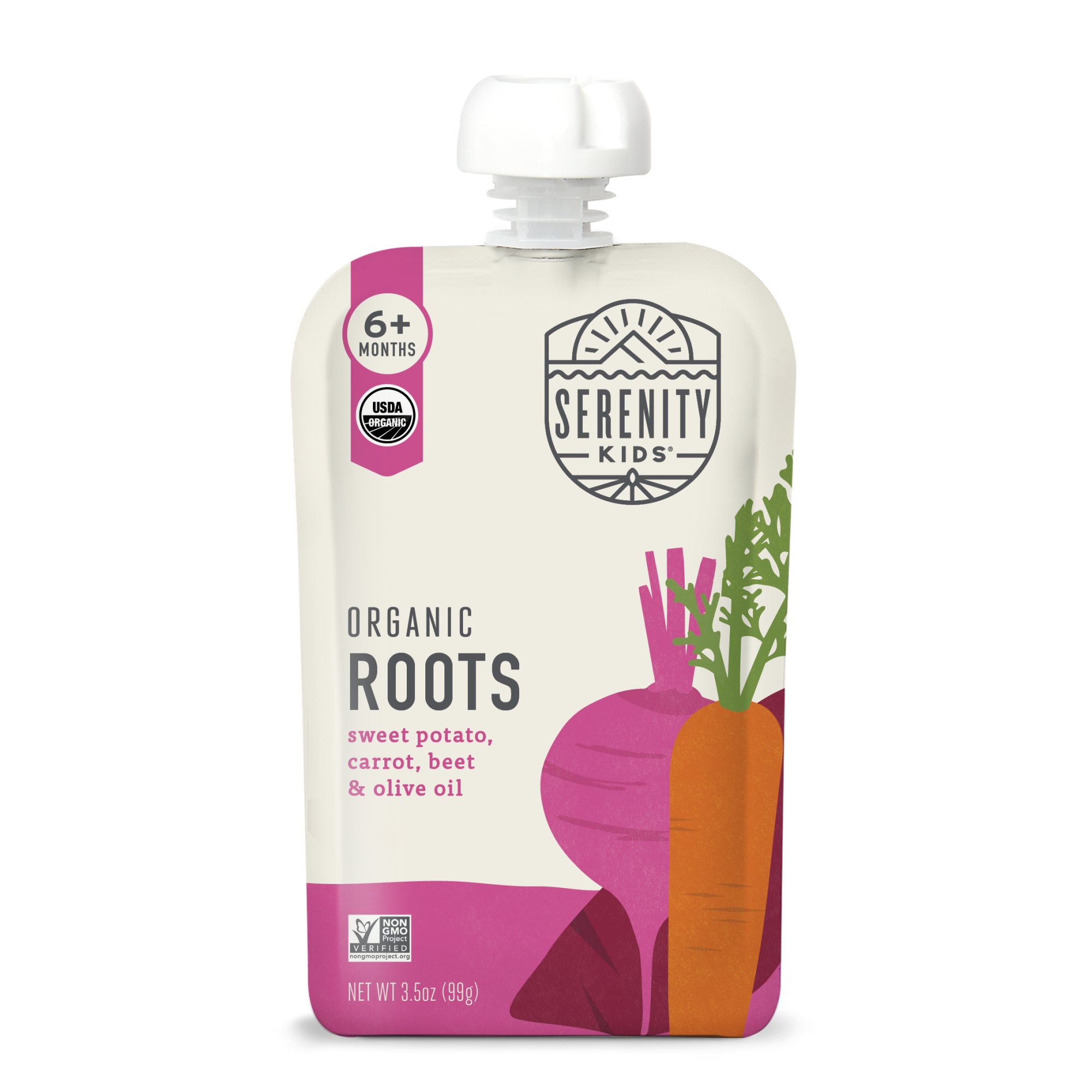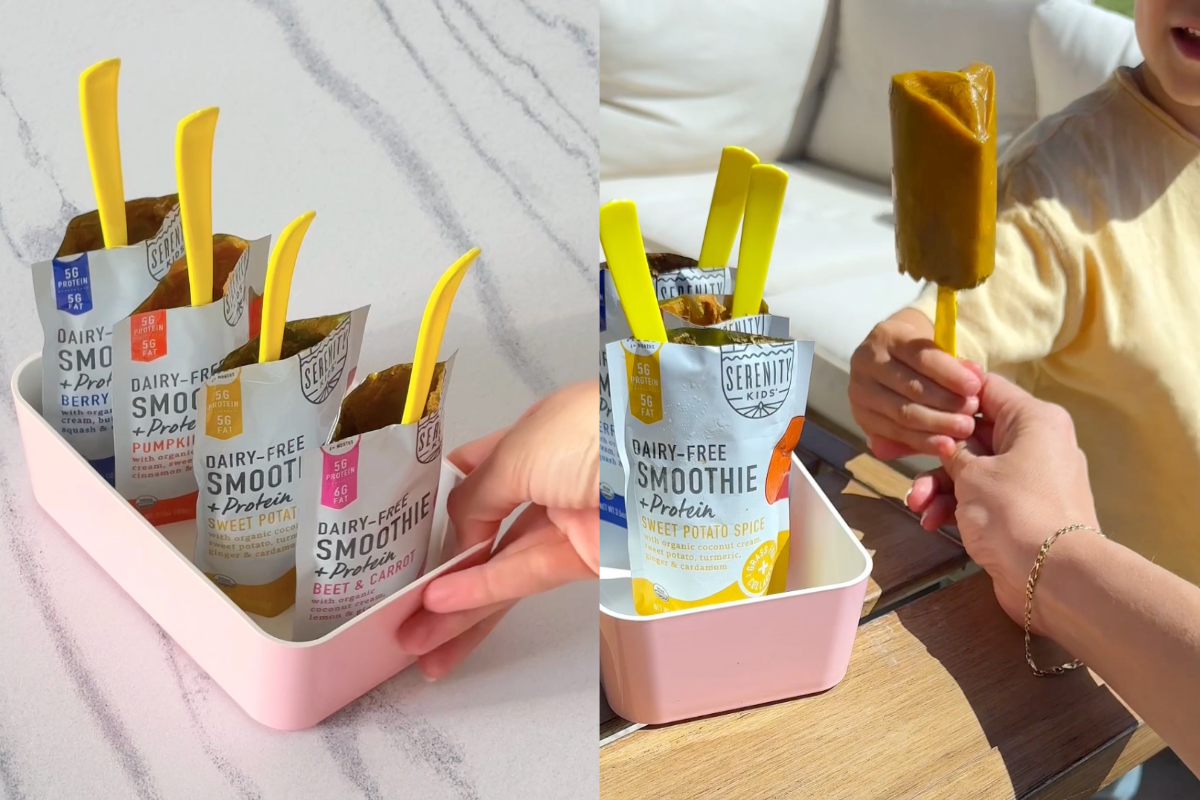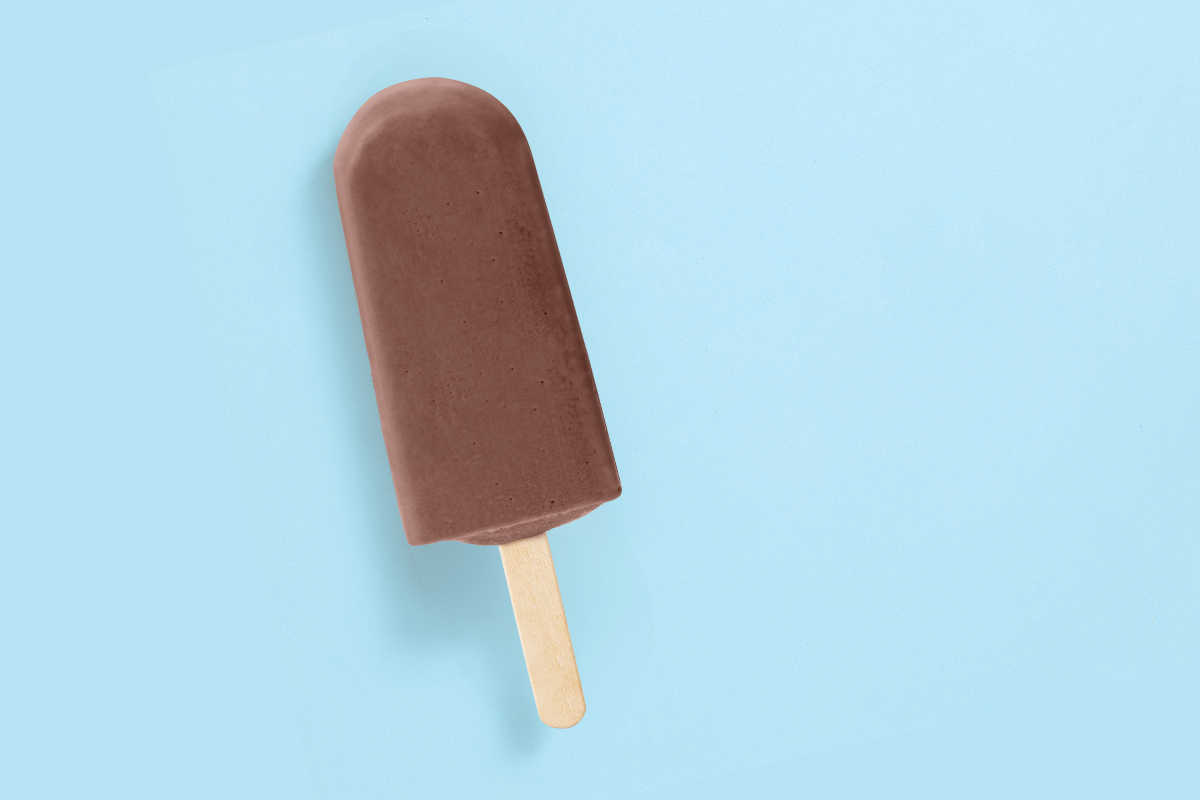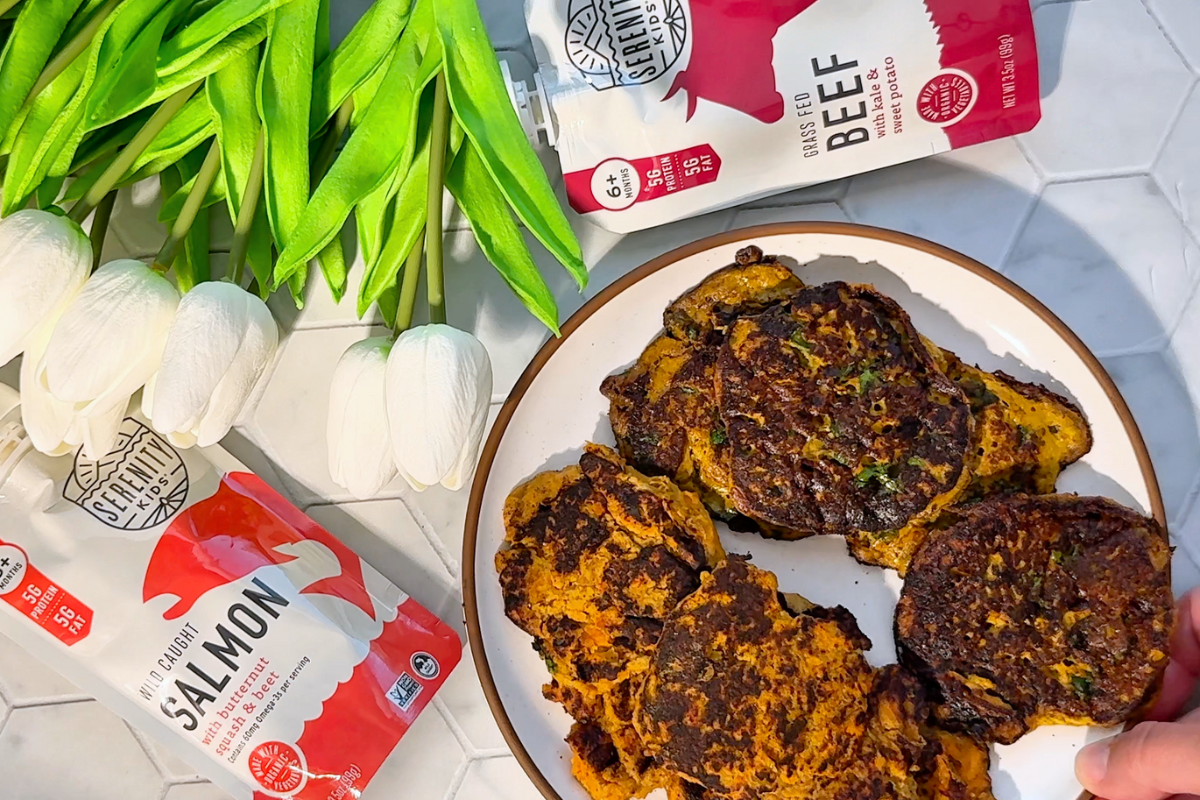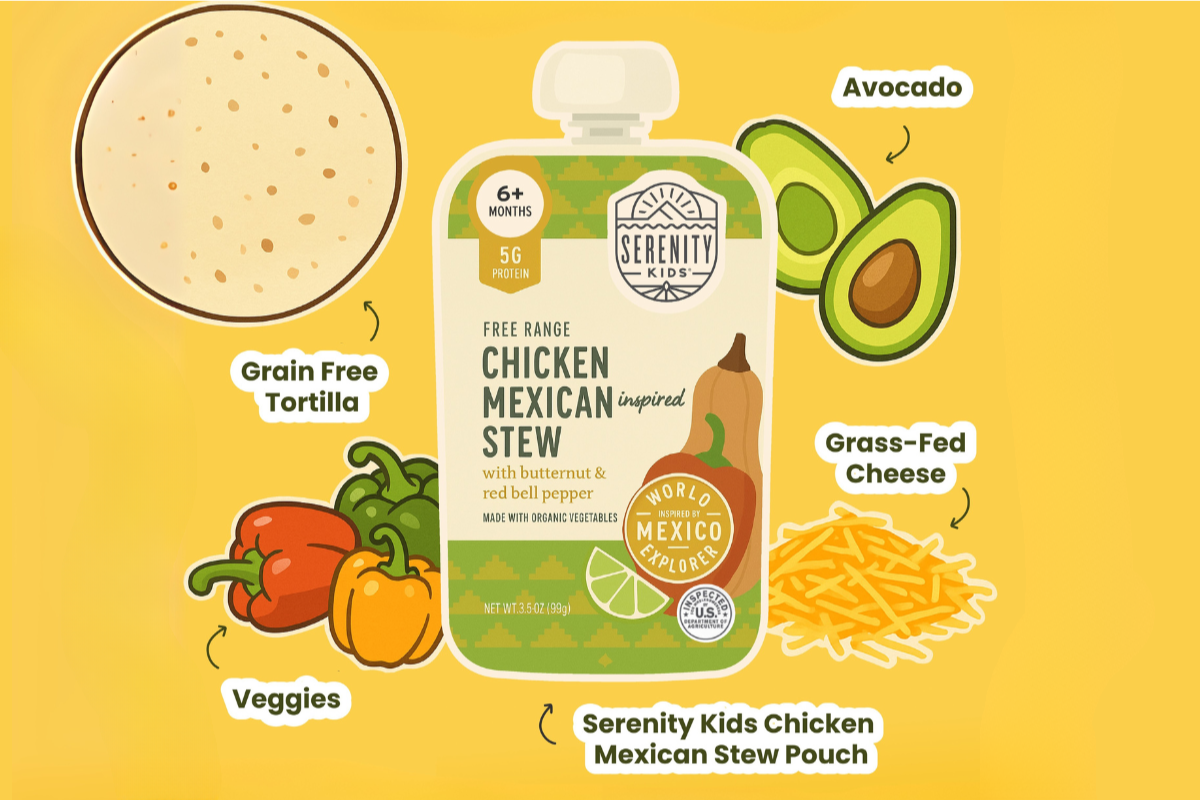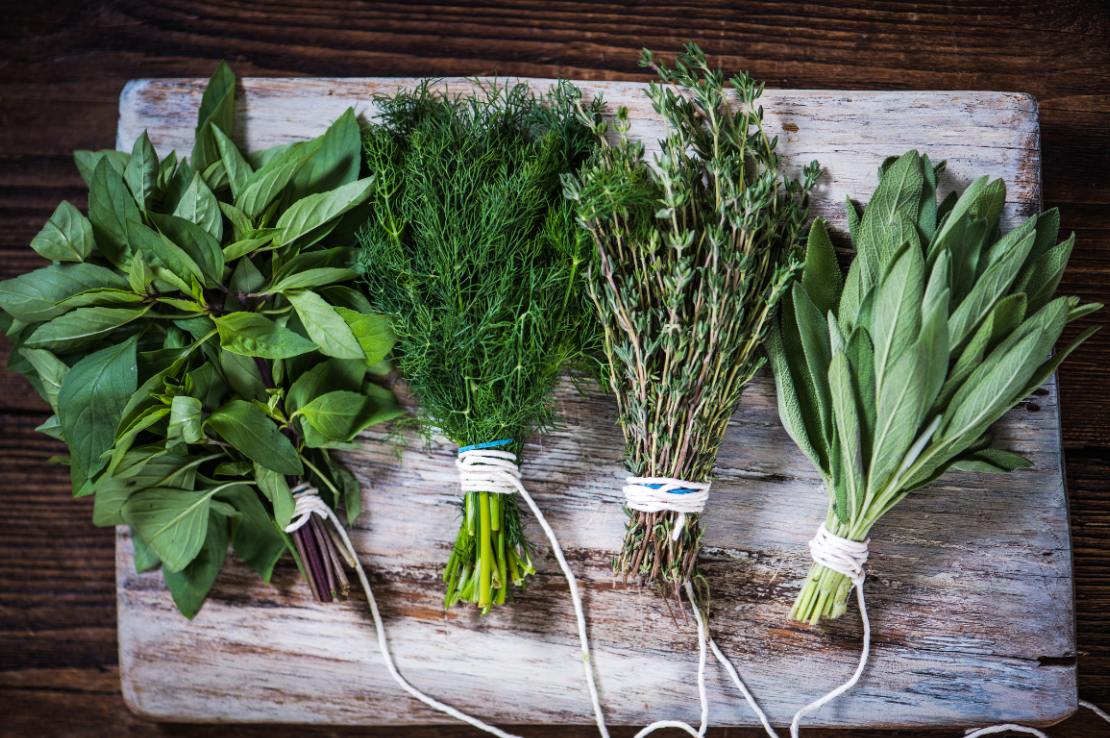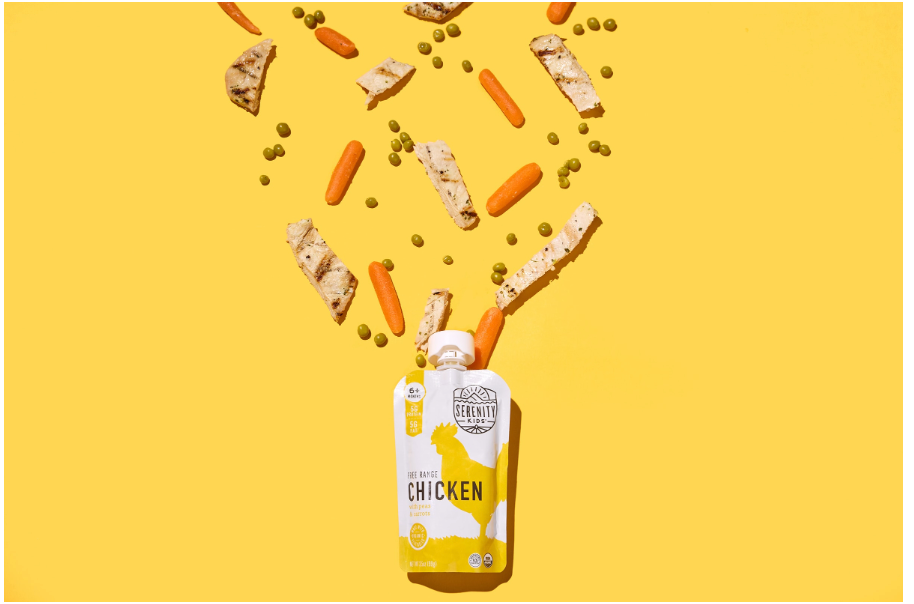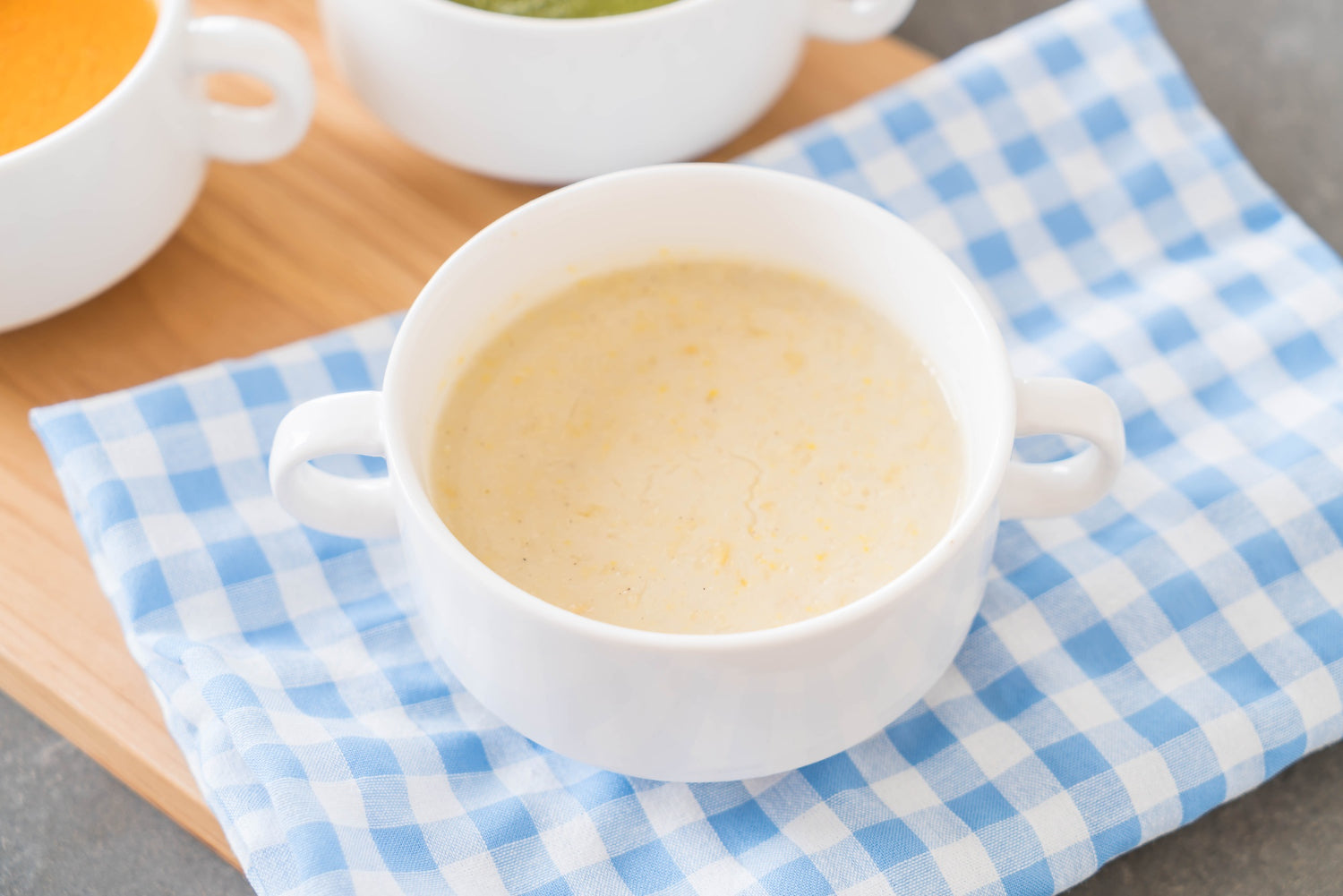When it comes to introducing solids, purees are often seen as the go-to. Purees can offer some serious nutritional benefits that differ from other feeding approaches - you can pack a LOT of goodies into a puree!
Plus, purees are pretty simple to make at home. When you make purees at home, you can control the texture and consistency. This allows you to tailor the puree to your baby's preferences and readiness. You can start with a very thin consistency so that it is easy for baby to swallow and then work your way up to a chunkier puree for an added sensory experience once baby is accustomed to swallowing and eating from a spoon.
Finally, purees provide an easy way to add variety to a baby's diet, as they can be mixed and matched with different meats, veggies, fats, and other boosters like breast milk, bone broth, herbs, and spices.
Know that we aren't exclusively team puree. Serving foods “baby-led weaning” style also has its benefits, and we think a combination of approaches is great for a number of reasons.
In this blog post, we'll provide an overview of when and how to start solids, what tools you'll need, and some tips for storing and serving. We also share 22 ideas for homemade stage 1 baby food purees.
When Can Your Babies Start Eating Solid Foods? Learn The Signs
Starting to introduce foods can be really exciting for some parents, so there can be a tendency to try and do it a little too early. There is no reason to rush! There are no risks in waiting too long to start solids, however there are several risks associated with starting too early so when in doubt, wait!
How do you know when it’s time? While there is no strict timeline, there are signs that a baby may be ready to begin exploring new flavors and textures:
- Can sit upright well without support
- Has lost the tongue-thrust reflex (doesn’t automatically push solids out of the mouth with the tongue)
- Has good head control (does not bob or nod when unsupported)
- Is willing and able to chew (even if he or she does not yet have teeth)
- Is developing a pincer grasp (picks up food or other objects between thumb and forefinger)
- Is interested in food and is eager to participate in mealtime (may watch you closely as you eat, lean into food, or try to grab food off of your plate)
Many babies start to show these signs around six months of age, but every baby is different.
How Can You Introduce Food to a Baby?
It can be daunting to introduce food to your baby, so here are some tips:
1. Try a puree
Purees can be nutrient dense and less intimidating that solid foods since they are easy to swallow. they are a great way to give baby a little taste of new flavors. You can even load a spoon for baby and allow he or she to self-feed.
2. Start smart with solids
When feeding solids, start with foods that are mashed or large enough to hold, and cut small round foods in half, or break them up a bit yourself first by crushing them before giving them to baby.
3. Prioritize animal proteins
They're dense in critical nutrients like beef, liver, and salmon.
4. Let baby lead the way
Take the lead on offering foods, but allow them to set the pace while you keep an eye out for hunger and satiety cues. If baby is turning their head, closing their lips, or pushing food away, they're making it clear that they're done. Don't force it, even if they haven't eaten much.
5. Offer positive feedback
Food is a foreign experience for babies just starting to eat. Your smiles, silly faces, and positive words will offer reassurance to baby that they're in a safe space.
6. Be patient
You'll need some patience and have a sense of humor. It can be frustrating when you spend a bunch of time prepping homemade baby food only for them to take one bite and fling the rest of the floor, but it’s all part of the learning process!
For more tips on how to introduce baby to solid foods, check out Baby’s First Bites: Dos and Don’ts for Introducing Solids in a Safe and Stress-Free Way
Baby Food Stages: What is the Difference Between Them?
The baby food stages listed on baby food can be very confusing for parents and are not always used in a consistent way by the baby food industry. The idea behind labeling a food with a baby food stage is to help guide parents along a journey of introducing different foods and textures as baby progresses from simple ingredients and thinner smooth purees to multiple ingredients and thicker purees.
Truthfully, baby food stages can be a good guide, but they certainly aren't gospel when it comes to how you should feed your baby. What's more important is to observe your baby and follow their lead. Parents know best, so if your baby is clearly bored with their runny sweet potato baby food, it's time to ramp up the texture and flavor!
In general, here's how baby food stages are defined:
1. Stage 1 baby foods
Stage 1 baby foods are typically the first baby food stage served around six months and are a watery puree of a single ingredient.
2. Stage 2 baby foods
Stage 2 baby foods are intended for around 6 to 9 months and are a thicker texture that is strained or mashed.
3. Stage 3 baby foods
Stage 3 baby foods are intended for around 10 to 12 months and are a mushy but chunkier texture.
But again, these are not hard and fast rules. Most “stage 3” purees are fine for babies as young as 6 months old, and older babies might still like the “stage 1” purees so use your own judgment.
Approaches to Baby Food
There are different approaches to introducing solids or “complementary feeding” as it is sometimes called. There is no one right way to feed a baby, which is why we love a combination of the different approaches (more on that here!):
1. Baby-led weaning
Baby-led weaning is an approach that has parents offer babies safely prepared versions of whole food items, such as soft cooked chunks of sweet potato, broccoli, or salmon baby food, etc. This allows baby to take the lead on what and how much they choose to eat. It's a great way to give baby a sensory experience and help them be part of mealtime with the rest of the family.
2. Purees
As we discussed, purees have a number of benefits, from nutrient density to ease of eating. It’s also the best way to introduce meat (an essential first food) which can be hard to chew for a little one with no teeth.
3. Eating with fingers
Eating with fingers isn't exactly an "approach" to baby feeding, but more of a stage. Offering finger foods is a great way to practice the pincer grasp. Our puffs are a great way to practice alongside other finger foods.
Best Tools for Making Homemade Baby Food Purees and Eating Essentials
To set yourself up for success in preparing stage 1 baby food purees, you'll need some tools.
-
Steamer basket (if you plan to steam veggies or meat before pureeing)
-
Blender, immersion blender, or food processor (for the pureeing step)
-
Silicone ice cube trays (we love Wee Sprout)
-
Freezer bags (we love Stasher)
-
Storage containers (we love Wee Sprout)
-
Pouches (for homemade purees, we love the reusable pouches from Wee Sprout, and of course our own Serenity Kids pouches as a backup or portable option)
-
Medium saucepan (if you plan to steam or saute veggies or meat, preferably cast iron or stainless steel)
-
Nontoxic baking sheet (if you plan to roast veggies or meat before pureeing)
-
Suction bowl and spoon set (optional, but super convenient)
-
Bib with a food catcher (we like the silicone ones that are easy to wash)
How Can You Store Stage 1 Baby Food Purees?
So what's the best way to store stage 1 baby food puree? You've got options! It is safe to store baby food puree in both the refrigerator or freezer, and which you choose depends on when you expect to feed it to your baby. A great option is a combo of both. Cooking a big batch of puree and leaving some in the fridge and freezing the rest is the ultimate baby meal prep. If you do this each time you try a new recipe, you'll end up with a great variety of your own stage 1 baby food in the freezer to pull out on busy days!
1. Refrigerator
If you expect that your baby will eat a puree within a few days, then the fridge is great option. We prefer to avoid plastics so we like to store baby food purees in glass jars (like these ones). Label your jar with the date the food was prepared so that you know when to toss it. Baby food purees are generally good for about 3 days in the fridge, however, if your baby has eaten directly from the container, you may need to toss it earlier since bacteria can build up inside once a spoon goes from baby's mouth back into the jar.
2. Freezer
If you don't expect that all of your puree will be eaten within about 3 days, the freezer is the better option. Silicone ice cube or baby food trays are a great tool to store frozen puree since you can pop out individual servings as you need them. Just be sure to cool baby food purees to room temperature before freezing. And if your baby is teething, you can let them chew on a cube of frozen baby food. Is messy but a fun way to feed and provide teething relief at the same time!
Baby Food Allergies: How Can You Tell?
When introducing solids to a baby, it is important to consider food allergies. Allergies to baby food are not always obvious - the signs can be subtle and easily mistaken for something else.
There are a few common symptoms that may indicate a food allergy:
- Rash or hives
- Vomiting or diarrhea
- Wheezing or difficulty breathing
- Swelling of the face, lips, or tongue
It can be scary to experience allergic reactions, so always seek medical attention if you notice any of these signs after feeding your baby. Allergic reactions might present right after a baby eats a new food or up to five days later.
It might seem counterintuitive but research shows that early allergen introduction is key to helping to prevent food allergies. Babies don't need much of a food to trigger an allergic reaction, or to help prevent food allergies. So-called "micro-exposures" of allergenic foods are enough to help prevent against developing food allergies, however it must be done at the right time with the right proportions, and most of the allergen introduction foods are not based on the scientific research. Ready Set Food is a brand we trust for this process, however we believe early allergen introduction is really only necessary for babies that are already at a high risk for allergies.
22 Ideas for Homemade Stage 1 Baby Food Purees
Many parents don’t realize that animal products, like meat, fatty fish, eggs, and liver, are ideal first foods for babies. The truth is, animal products are dense in the nutrients babies really need (like iron, zinc, and healthy fats) and are easier to digest than the grain-based baby cereal commonly recommended for babies. Plus, they have a savory flavor profile (read more on why meat is an ideal first food here). Fun fact: Our ancestors would pre-chew meat for their babies, called “pre-mastication”, as a way to serve pureed meats to baby. Since we now have blenders, that isn't necessary. Of course, go for it if you want!
After meat, veggies are the next best thing to introduce to baby. Veggies help introduce more savory flavors and nutrients. Veggies are great steamed, roasted, or sauteed and combined with some healthy fats like grass-fed ghee, whipped bone marrow, olive oil, avocado oil, or coconut oil.
Some fresh fruit is ok but can be high in sugar, and offering too much may lead to sweeter taste preferences and picky eating. We do not recommend grains, rice cereal, or baby cereal. For more on why, check out Why We’re Grain Free.
So here we go, 22 ideas for stage 1 baby purees:
1. Meats: grass-fed beef, free-range turkey and chicken, beef liver, chicken liver
Blend cooked meats (the fattier the better) with a little breast milk or formula, bone broth, or water,
2. Bone broth
Okay, bone broth isn’t really a puree, but it's super nutrient dense food and can be served in a bottle or cup. It can also be used to thin out other purees to your desired consistency. Check out our chicken bone broth and liver bone broth recipes.
3. Egg and Egg Yolk
Just cook it softly (can use grass fed ghee or bone marrow) and then mash it up!
4. Sweet potato
Just steam, saute, or roast sweet potatoes and then mash it up!
5. Avocado
All you need is a ripe avocado and then mash it up - as smooth or chunky as you'd like.
6. Peas
Just cook and blend them. They make a great thickener when mixed with other meats and veggies.
7. Carrot
Just steam, saute, or roast carrots and then mash them up! Find more ideas for carrot baby food here!
8. Butternut squash
Just steam, saute, or roast butternut squash and then mash it up!
9. Broccoli
Just steam, saute, or roast broccoli and then blend it up!
10. Cauliflower
Just steam, saute, or roast cauliflower and then blend it up!
11. Zucchini
Just steam, saute, or roast zucchini and then blend it up!
12. Asparagus
Just steam, saute, or roast asparagus and then blend it up!
13. Bell pepper
Just steam, saute, or roast bell pepper and then blend it up!
14. Pumpkin
You can buy pumpkin already pureed, or make your own, similar to butternut squash
15. Green beans
Just steam, saute, or roast bell pepper and then blend it up!
16. Spinach or kale
Just steam or saute spinach or kale and then blend it up!
17. Mango
Just blend it up (and consider combining with a fat like avocado once introduced so it isn't pure sweetness).
18. Peach
Just blend it up (and consider combining with a fat like avocado once introduced so it isn't pure sweetness).
19. Blueberry
Just blend it up (and consider combining with a fat like avocado once introduced so it isn't pure sweetness).
20. Strawberry
Just blend it up (and consider combining with a fat like avocado once introduced so it isn't pure sweetness).
21. Pear
Just blend it up (and consider combining with a fat like avocado once introduced so it isn't pure sweetness). These can help if baby is a bit constipated.
22. Plums and prunes
Just blend it up (and consider combining with a fat like avocado once introduced so it isn't pure sweetness). These can help if baby is a bit constipated.
Bon Appetit!
There are a variety of approaches you can take, and decisions around what and how to feed can feel overwhelming. But ultimately, introducing solids should be a fun and exciting journey for you and your little one! Try a variety of flavors, textures, and methods of eating to see what your baby enjoys. And remember, preferences might change daily, so go with the flow and follow their lead!



